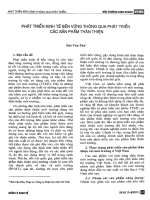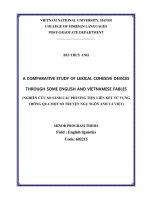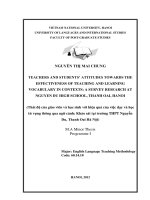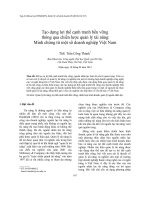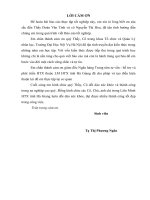Vocabulary enhancement teaching affixes to secondary school students = nâng cao vốn từ vựng thông qua việc dạy phụ tố cho học sinh graduation paper, major english pedagogy
Bạn đang xem bản rút gọn của tài liệu. Xem và tải ngay bản đầy đủ của tài liệu tại đây (627.9 KB, 50 trang )
HO CHI MINH CITY, June 18th, 2019
NAME: Lương Nguyễn Hương Nguyên
STUDENT ID: 15DH710437
EMAIL ADD:
DATE SUBMITTED: June 18th, 2019
WORD COUNT: 5238
STUDENT DECLARATION
I DECLARE THAT THIS ASSIGNMENT IS ORIGINAL AND HAS NOT BEEN SUBMITTED FOR ASSESSMENT ELSEWHERE .
I DECLARE THAT THIS ASSIGNMENT IS MY OWN WORK AND DOES NOT INVOLVE PLAGIARISM OR COLLUSION .
NO OTHER’S WORK OR IDEAS HAVE BEEN USED WITHOUT ACKNOWLEDGEMENT, EXCEPT WHERE I CLEARLY STATE THAT I
HAVE USED SOME OF THE MATERIAL ELSEWHERE
NAME/ SIGNATURE
DATE: 18/6/2019
Lương Nguyễn Hương Nguyên
ADVISOR’S ASSESSMENT
Page | 1
_______________________________________________________________________
_______________________________________________________________________
_______________________________________________________________________
_______________________________________________________________________
_______________________________________________________________________
_______________________________________________________________________
_______________________________________________________________________
_______________________________________________________________________
_______________________________________________________________________
_______________________________________________________________________
_______________________________________________________________________
_______________________________________________________________________
_______________________________________________________________________
_______________________________________________________________________
_______________________________________________________________________
_______________________________________________________________________
_______________________________________________________________________
_______________________________________________________________________
_______________________________________________________________________
_______________________________________________________________________
_______________________________________________________________________
_______________________________________________________________________
_______________________________________________________________________
_______________________________________________________________________
_______________________________________________________________________
ABSTRACT
Page | 2
Word formation plays an important role in not only enhancing vocabulary
but also supporting students in accomplishing language tasks. Because of its
importance, students’ methods of learning new words, their attitudes and
awareness towards word formation, and their results of two tests were
analyzed. Then some suggestions were made to improve the effectiveness of
teaching word formation. The total participants were 100 ninth-graders from
Nguyen Gia Thieu secondary school in Tan Binh District, Ho Chi Minh City.
The data analysis demonstrated students’ remarkable improvement after
being taught affixes. In a comprehensive view, teaching affixes had a
considerable impact on students’ performance.
Page | 3
TĨM TẮT
Cấu tạo từ đóng một vai trị quan trọng khơng chỉ trong việc nâng cao vốn từ
vựng mà cịn hỗ trợ học sinh hoàn thành các bài tập về ngôn ngữ. Với tầm
quan trọng của cấu tạo từ, các phương pháp học từ vựng của học sinh, thái
độ và nhận thức của học sinh về cấu tạo từ, và kết quả của họ trong hai bài
kiểm tra sẽ được phân tích. Bài nghiên cứu này cũng sẽ đưa ra những đề xuất
để cải thiện hiệu quả trong giảng dạy về mảng cấu tạo từ. Tổng số học sinh
lớp 9 từ trường trung học cơ sở Nguyễn Gia Thiều quận Tân Bình, thành phố
Hồ Chí Minh tham gia bài khảo sát là 100. Số liệu được phân tích đã cho thấy
sự tiến bộ rõ rệt của học sinh sau khi được dạy về các phụ tố. Nhìn chung,
việc giảng dạy phụ tố có ảnh hưởng đáng kể đến kết quả học tập của học sinh.
Page | 4
ACKNOWLEDGEMENTS
First and foremost, I appreciate the opportunity that The Board of
Directors and the members of the Foreign Languages Department gave me to
conduct this research.
I would like to express my deep gratitude towards my advisor Yen
Chau for her expert guidance, understanding, and especially encouragement
throughout my project. She has always been very enthusiastic and open to
discussions as well as providing constructive comments and orientation. Had
it not been for her patience and support, this thesis would not have been
possible.
I am highly indebted to the principal, the teachers, and all the
participants of secondary school Nguyen Gia Thieu for their cooperation.
I would also like to express my sincere appreciation towards my
wonderful parents for their unceasing support and encouragement. They have
always been there for me, supporting me in every possible way.
Last but not least, I would like to thank my friends for their great help
and feedback. Special thanks are sent to Hoa Tang Khanh, who has helped
me with technical issues on various occasions and has been willing to read
and provide feedback on my writing. Thanks should also be sent to Thu Le
for candid discussions and support throughout my project.
Page | 5
TABLE OF CONTENTS
ABSTRACT……………………………………..…………………………3
Chapter 1. INTRODUCTION …………………………..……………8-10
1.1. Background…………………………………………………….8
1.2. Scopes…………………………………………………………...9
1.3. Research Objectives……………………………………………9
1.4. Research Questions…………………………………………...10
1.5. Organization…………………………………………………..10
Chapter 2. LITERATURE REVIEW……………………………….11-16
2.1. Definitions and Hypothesis…………………………………..11
2.2. Vietnamese Students’ Difficulties in Learning English
Vocabulary………………………………………………………...12
2.3. Effects of Morphological Awareness...………………………13
2.3.1. Effects of morphological awareness on vocabulary
size…………………………………………………………...13
2.3.2. Effects of morphological awareness on reading…...14
Chapter 3. RESEARCH METHODOLOGY……………………….17-20
3.1. Overview of Previously Applied Methods..…………………17
3.2. Overview of the Experiment…………………………………18
3.3. Subjects of the Experiment…………………………………..19
3.4. Procedures…………………………………………………….19
Chapter 4. DATA ANALYSIS.............................................................21-24
4.1. Background Information of Students……………………….21
4.2. Students’ Awareness of and Attitudes towards Word
Formation……………………………………………………….....22
Page | 6
4.3. Students’ Vocabulary Learning Methods.…………………..23
4.4. Students’ Performance in the Pretest and Posttest…………25
4.5. Students’ Suggestions………………………………………...26
Chapter 5. THE PROCEDURE OF TEACHING WORD
FORMATION……………………………………………………………27
Chapter 6. CONCLUSION AND RECOMMENDATION……………43
6.1. Limitations of the Current Study……………………………43
6.2. Further Research……………………………………………..43
REFERENCES...........................................................................................44
APPENDICES .……………………..........................................................47
Page | 7
CHAPTER 1. INTRODUCTION
Globalization has offered many advantages to most countries’
development. Thus, to integrate successfully, learning an international
language is essential, which makes the demand for mastering the English
language now higher than ever (Crystal, 2012). At the very first stages, to
learn a language is equivalent to learn how to develop the four basic skills
(listening, reading, speaking, writing) effectively (Hinkel, 2006), and the
framework to build up those is vocabulary (Alqahtani, 2015). Among a
plethora of different vocabulary teaching strategies, teaching word formation
is considered one of the most useful methods to learn new words (Kame'enui
& Baumann, 2012). This research will collect data from Vietnamese ninth
graders, who study English as a foreign language.
1.1. Background to the Study
Enriching vocabulary is among the most fundamental aspects of
learning a language for the enormous benefits it provides to learners. A large
vocabulary size can help learners improve their reading comprehension
(Hiebert & Kamil, 2005), fluency in communication (Boonkit, 2010),
accuracy in aural tasks (Smidt & Hegelheimer, 2004), and quality of writing
works (Olinghouse & Wilson, 2013). Therefore, a myriad of researches on
vocabulary learning strategies have been conducted; however, most of them
explore memory strategies or rehearsal strategies (Crothers & Suppes,
1967; Lado, Baldwin, & Lobo, 1967), ignoring examining whether word
formation is an effective method to develop vocabulary. Besides, selecting
the words that are worth focusing on is among the most major challenges
since one’s lexicon is limited. Therefore, breaking a word into small,
Page | 8
understandable segments by learning how a word is formed through the
combination of a base word and affixes, learners can build a much larger
vocabulary size more effortlessly. Hence, understanding the formation of
words is considered a critical component of learning new words (Schmitt &
Zimmerman, 2002).
With word formation, students just need to learn a base word and the
affixes instead of learning words separately (Gu & Johnson, 1996). In
Vietnam, the usefulness of learning word formation has been disregarded or
ignored while it greatly helps students in both word form and Reading tasks
of entrance exams. The common method chosen to teach vocabulary is
memory method by repeating words many times, which can build a
conditioned reflex for quick recognition of the words. Nonetheless,
vocabulary learnt this way will only be archived in short-term memory and
be faded if no constant repetition is carried out (Gu & Johnson, 1996). Hence,
profound grasp of how a word is formed is considered a necessity for
successful foreign language learning.
1.2. Scopes
There are also many other strategies for teaching and learning
vocabulary (Gu & Johnson, 1996); however, this research paper will only
focus on the guessing strategy due to its limited scope.
The research will be carried out in Nguyen Gia Thieu secondary school
in Tan Binh District, Ho Chi Minh City, Vietnam.
1.3. Research Objectives
This study aims to examine whether teaching affixes is an effective
approach to increase vocabulary size for secondary school students.
Page | 9
1.4. Research Questions
Is teaching affixes an effective method for increasing students’
vocabulary size?
1.5. Organization
The organization of this study includes five parts. First, the general
view of the importance of learning vocabulary is stated along with current
situation of the word formation teaching and learning in Vietnam in section
1. In section 2, academic literature, which depicts a general picture of the
effects of affixes awareness on one’s vocabulary size and reading skills will
be reviewed. The methodology introduced in section 3 will include 4 steps:
(1) identifying research subjects, (2) setting up a list of questionnaire, (3)
determining the methods to collect data, and (4) analyzing the collected data.
The results obtained will be discussed in section 4. In the last part,
conclusions and recommendations will be proposed.
Page | 10
CHAPTER 2. LITERATURE REVIEW
In general, the hypothesis of morphology, which is the study of word
formation, having huge impacts on learning a language has strongly been
supported (Nation & Waring, 1997; Bauer & Nation, 1993; etc.). First, in this
chapter, not only the definitions of morpheme, word formation,
morphological awareness, and the hypothesis of their relations but also the
Vietnamese students’ difficulties in vocabulary size increase will also be
discussed. Second, the effects of morphological awareness on vocabulary
size and reading will be introduced.
2.1. Definitions and Hypothesis
Morpheme is “a meaningful unit that contains no smaller meaningful
unit” (Cruz-Ferreira & Abraham, 2006, p.58) or “a minimal unit of meaning
or grammatical function” (Yule, 2016, p.67). Word formation is the process
consisting of rules that “tell us among other things how the morphemes are
to be arranged in sequences to form actual words” (Halle, 1973, p.3), or
according to Cruz-Ferreira & Abraham (2006), “word formation concerns the
processes that allow us to create new words with grammatical resources
already available within a language” (p.68).
In order to learn word formation efficiently, having a firm grasp of the
word forming process, which is equivalent to having an intense
morphological awareness, is necessary (Bauer & Nation, 1993). Morphology
is a branch of linguistics that studies “how language works, revealing the
need for different categories of words, the presence of word-internal
structure, and the existence of operations that create and modify words in
various ways” (O'Grady, Dobrovolsky, & Katamba, 1997, p.109). Therefore,
Page | 11
morphological awareness, according to Carlisle (1995), is “awareness of
morphemic structure of words and the ability to reflect on and manipulate
that structure” (p. 194).
The hypothesis about learning word formation having huge impacts on
learning vocabulary process is strongly supported by many previous studies.
In fact, the more knowledge boundary of affixation broadens, the more a
learner is able to broaden the size of the vocabulary (Bauer & Nation, 1993),
and “knowledge of the members of a word family is essential to productive
language use” (Schmitt & Zimmerman, 2002, p.4). Hence, teaching word
formation can also help learners, especially the ones studying English as a
foreign language, have profound understandings and know how to apply low
frequency words without wasting too much time on teaching each word
(Nation & Waring, 1997). Therefore, applying morphology into teaching
English is considered to be a sufficient method for learning vocabulary, since
it can also enhance the quality of reading skills.
2.2. Vietnamese Students’ Difficulties in Learning English Vocabulary
Learners’ ability to learn English depends greatly on his/her home
language background (Ramirez, Chen, Geva, & Luo, 2011). While other
Asian countries utilize English as a second language such as the Philippines,
Singapore, and Malaysia, Vietnam still uses English as a foreign language.
There is a small number of Vietnamese children being exposed to the English
speaking environment at very young ages in English centres; nevertheless,
this type of environment only remains in a short period of time. Those
children still speak Vietnamese language once they return home. It means
that they do not have opportunity to practice English in real life contexts.
Page | 12
Thanks to Alexandre de Rhodes, who exerted one of the most
significant effects on the Vietnamese culture - the alphabet in Latin
orthography in 1651, the Vietnamese have a considerable advantage in
learning English in comparison to the ideogram system of Chinese or Korean.
The alphabet of Vietnamese language also bears considerable similarities to
those of English, French, or Spanish; however, its word formation is different
from those. The Vietnamese language is monosyllabic; there are no such
concepts like inflection, derivation, or prefixes. French, Spanish, and English
are cognate languages, so they have a large number of words combined by a
root and prefixes. For example, French and English both have the word
communicable that is the combination of the root communicate and the suffix
-able with the same meaning - able to be communicated.
2.3. Effects of Morphological Awareness
Developing morphological awareness appears to have a significant
effect on facilitating vocabulary learning process, which has a great influence
on reading comprehension (Hiebert & Kamil, 2005; Stahl & Nagy, 2006).
2.3.1. Effects of morphological awareness on vocabulary size
Since vocabulary is considered the priority in learning English,
developing an effective method to expand one’s vocabulary size is necessary.
According to Templeton, “most words in the English language have been
created through morphological processes” ( 2012, p.117), raising
morphological awareness can enhance the rapidity and accuracy of the
written words identification process by breaking down low frequency words
into familiar segments. In fact, quite a few researches have found that
morphological awareness gives a great advantage to English language
Page | 13
learners at young ages since in this period of time, morphological awareness
is apt to develop considerably (Berninger, Abbott, Nagy, & Carlisle, 2010).
Kuo & Anderson (2006) stated that children with more profound
understandings about morphology gain more benefits in “acquiring and
retaining morphologically complex words” (p.162). Goodwin, Huggins,
Carlo, August, & Calderon (2013) also claimed upper elementary learners’
fluency of English language depends greatly on morphological knowledge.
Similarly, Anglin (1993) found that elementary students had applied their
morphological knowledge about base words and suffixes into figuring out
meaning of low frequency words.
2.3.2. Effects of morphological awareness on reading
Reading, which includes many subskills and components such as
linguistic, cognitive, and socio affective features (Carr, Brown, Vavrus, &
Evans, 1990), is one of the most fundamental and complex skills (Koda,
2007). Learning to read is not simply learning to convert words in
orthographic forms into those in phonological forms; it also includes
comprehension of the words in the writing system and the implied meanings
the authors want to transfer (Kuo & Anderson, 2006). Therefore,
morphological awareness, which includes knowledge of meaning in a
language and how to combine morphemes into understandable words (Kuo
& Anderson, 2006), can partially facilitate learning process and help English
language learners, especially ones who study English as a foreign language
like the Vietnamese.
Guessing is among the most useful techniques in reading since one’s
lexicon is limited. In some reading tasks, readers are required not only to
Page | 14
skim fast but also to recognize low frequency words, which are
morphologically complex words (Chafe & Danielewicz, 1987). A plethora of
researches have shown that derivational awareness contributes a lot to
English word reading (Carlisle & Fleming, 2003; Deacon & Kirby, 2004;
Kuo & Anderson, 2006). According to Kieffer and Lesaux (2012),
morphological
awareness
has
a
considerable
effect
on
reading
comprehension. Carlisle (2000) suggested that morphological awareness
may be essential in developing reading skills for learners in middle schools.
Scott & Nagy (2004) also stated that morphological awareness plays an
essential role in reading comprehension. A person’s ability to figure out a
complex word meaning greatly depends on his/her knowledge of known base
words (Kuo & Anderson, 2006). For example, readers at elementary levels
may probably be confused about the word bipolar although they know the
root word polar. In contrast, those who read frequently can analyze that
bipolar is the combination between the prefix bi- and the word polar but not
a new word with a completely different meaning.
In reading passages, words with affixes with familiar base form can
hinder reading process. For example, three words celebration, freedom and
colorful (Unit 8, ninth grade textbook) with base words: celebrate, free and
color respectively are familiar to students but most of them think these words
are completely new words.
Although there are many celebrations throughout the year, Tet or the
Lunar New Year holiday is the most important celebration for Vietnamese
people. Tet is a festival which occurs in late January or early February. It is
a time for families to clean and decorate their homes, and enjoy special food
Page | 15
such as sticky rice cakes. Family members who live apart try to be together
at Tet.
Passover is in late March or early April. This festival is celebrated in
Israel and by all Jewish people. On this festival, people celebrate freedom
from slavery. Passover is also an ancient spring festival. On the first and
second nights of Passover, Jewish families eat a special meal called the
Seder.
Easter is a joyful festival which is celebrated in many countries. It
happens at around the same time as Passover. On Easter Day (Easter
Sunday), young children receive chocolate or sugar eggs – as long as they
are good. In many countries, people crowd the streets to watch colorful
parade.
Page | 16
CHAPTER 3. METHODOLOGY
3.1. Overview of Previously Applied Methods
Previous studies on teaching and learning vocabulary have utilized a
variety of methods for data collection. While some studies used only one
method (Kuo & Anderson, 2003; Carlisle, 2000; Goodwin, Huggins, Carlo,
August & Calderon, 2013; Kieffer & Lesaux, 2012; etc.), many others
deployed combined methods (Ramirez, Chen, Geva & Luo, 2011; Gu &
Johnson, 1996; Schmitt & Zimmerman, 2002; etc.).
Kuo & Anderson (2003) used only tests to collect data from 436
Taiwanese students. Necessary information such as the affixes being taught
to those students or the methods Chinese teachers emphasized of teaching
vocabulary to students were provided to the researchers by the teachers. The
results showed that 32% of the Chinese participants, who could identify the
derivative words better, gained higher scores in the reading tasks. Their study
confirmed that the relationship between morphological awareness,
vocabulary knowledge and reading comprehension strongly supported
students in developing reading skills.
3.2. Overview of the Experiment
This study, therefore, conducted a survey, pretest, and posttest for their
benefits and suitability for the research purpose. The survey included 10
questions on students’ personal information and opinions about word
formation. A survey, which was defined as “an excellent vehicle for
measuring a wide variety of unobservable data” (Bhattacherjee, 2012, p.73),
might help both participants and researchers save time and effort. A
questionnaire survey will be used since it adequately fulfils all the
Page | 17
requirements of this study. The benefits of this type of survey are high rate
responses and immediate explanations if there are any ambiguities in the
questionnaire. Those questions will focus on three main points: (1) the extent
of students’ awareness of word formation importance and application, (2) the
methods students use to learn word formation themselves, and (3) their
suggestions for a more effective teaching method.
With the pretest and posttest, the link between cause and effect through
treatment manipulation can become obvious. This method category can
reflect accurately, especially in education, the degree of teaching
effectiveness. Since Vietnamese ninth-graders’ level is only equivalent to
beginners or pre-intermediate, both the pretest and posttest, which included
10 questions about word formation, were constructed in the simple form of
filling in the blanks. All the 20 words selected for the tests were highfrequency words, which were introduced in secondary school English
textbooks. Affixes chosen in the posttest all have their own principles;
therefore, students could quickly understand and apply them to the test (e.g.,
prefix -ir). 20 words were chosen including irreligious, retake,
underestimate, impolitely, overwork, investigation, populous, inventive,
electrify, interviewee, dependable, preservationist, sugarless, simplify,
persuasion, interactive, irregular, impatient, endanger, oversleep. The
purpose of the pretest was to figure out the extent of students’ ability in
identifying and selecting suitable affix for each word. The posttest aimed to
examine whether teaching affixes to these students could enhance their
performance in this type of exercise. The scores of the two tests will be
analyzed and compared in order to reach the conclusion.
Page | 18
3.3. Subjects of the Experiment
100 ninth-graders in Nguyen Gia Thieu secondary school in Tan Binh
District were chosen randomly to complete the questionnaire and the two
tests.
3.4. Procedure
The questionnaire, pretest and posttest, which were created by
Microsoft Word 2013, were handed to the participants. By using this data
collection method, researcher could have actual interaction with the students
and absolute control on time.
Firstly, the researcher asked for the permission of Nguyen Gia Thieu
secondary school’s principal to collect data from ninth-graders. After the
researcher received the approval of the parents/guardians of 101 students, the
survey and the pretest were assigned to these students to be completed. The
researcher explained how to answer each question to the students, so that they
could all complete the survey and start the pretest at the same time. There
was no further instruction or explanation for the pretest. After completing the
questionnaire, those students did the pretest in 10 minutes, and when they all
finished, both the questionnaire and pretest were handed to the researcher.
The researcher then taught word formation to students once a week for four
weeks. Subsequently, the students did the posttest in the fifth week. The
whole process lasted for five weeks.
Page | 19
CHAPTER 4. DATA ANALYSIS
Quantitative data, which included the students’ background
information on studying vocabulary, consciousness of importance of word
formation, and the two tests results are used to answer whether teaching
affixes to secondary school students is an effective method in increasing
vocabulary.
4.1. Background Information of Students
Figure 4.1. Number of years students learning English
The number of years students have learnt English is divided into three
kinds: 4 years, 4-6 years and more than 6 years. 4-year time signifies that
students only started learning English at grade 6, when English is a
compulsory subject. In contrast, more than 6 years implies that students had
learnt English from grade 1 or 2. More than ¾ participants (83%) stated that
they had learnt English for more than 6 years, and the number of students
Page | 20
choosing 4 years accounted for 8%. This strongly supports the
aforementioned that students these days have been exposed to English at very
young ages.
More than a half of total participants (66%) attended extra classes
while 29% chose English centers where they learn English, and only 5%
studied at home by themselves. Surprisingly, all the students who studied at
home had learnt English for more than 6 years. According to the findings,
studying English after school at extra classes and English centers is common
to the majority of ninth-graders, which implies that students have at least two
different English input environments.
4.2. Students’ Awareness of and Attitudes towards Word Formation
Figure 4.2. Students’ opinions on the necessity of word formation
Page | 21
Almost all the participants (95%) agreed that word formation was
necessary for their English learning process while only 5% found the
opposite. However, there is a discrepancy between their opinions on word
formation and teachers focusing more on it. 87% students thought that
teachers should put more emphasis on teaching how a word is formed.
Besides, the number of students found interested in a word forming process
is even smaller, only 85%. It can be concluded that although students were
aware of the essential role of word formation, they still did not have a strong
motivation to study. This might come from two main reasons: unsuitable
teaching method, ambiguous definition and purposes of word formation.
4.3. Students’ Vocabulary Learning Methods
Repeating or rewriting
new words
27%
18%
8%
5%
17%
10%
15%
Applying into
Learning through affixes
and base words
Figure 4.3. Students’ strategies for learning vocabulary
real contexts
Page | 22
Combined methods are widely selected by the participants. 46% chose
learning meanings of base words and affixes as one of their learning
vocabulary strategy. However, 58% of the students chose rote memorization
strategies or visual repetition, which means they would rewrite the words
many times or repeat them by reading aloud.
The creation of a new word
23%
26%
2%
7%
16%
A way to learn vocabulary
6%
20%
A kind of exercise
Figure 4.4. Students’ point of view about word formation
As mentioned in 4.2, students have little interest in learning word
formation. Based on the figure 4.3, an explanation can result from students’
understanding, since even the students that learned vocabulary through parts
of words actually did not all deeply understand what word formation really
was. The right definition of word formation is the creation of a new word,
not a kind of exercise or a way to learn vocabulary. Word formation just
Page | 23
supports students in identifying and guessing new words. Therefore, only
23% had a firm grasp of the concept of word formation. An explanation for
this can be the method word formation being taught. Word formation has
been treated as a category of exercise without further applications.
4.4. Students’ Performance in the Pretest and Posttest
45
40
Number of students
35
30
25
20
15
10
5
0
1
2
3
4
5
6
7
8
9
10
Axis Title
Pretest
Posttest
Figure 4.5. Students’ performance in the two tests
The results of both the pretest and posttest suggests that teaching
affixes to secondary school students is an effective method for vocabulary
enlargement. Indeed, except for 33% of the participants who performed
well in both the pretest and posttest (8 correct answers in the pretest and 10
in the posttest, for instance), approximately 32% of the participants
achieved at least 5 more correct answers in the posttest.
Page | 24
Figure 4.6. Descriptive statistics of the pretest and posttest
After word formation was taught, the results were really positive: 41%
of the students achieving 100% correct answers in the posttest while that
percentage in the pretest is 1%. In comparison between the modes of the two
tests, there is a marked discrepancy. The mode of pretest is 4 (20 cases) and
that of posttest is 10 (41 cases). Almost all of the students showed
improvement in the posttest; the mean of the tests rise from 4.62 to 7.9.
Page | 25
